Types of Vignette Finishing
If you have a sound card on your PC or are visiting this page with a tablet or smartphone, we have summarised the entire content of this page - and the entire vignette porcelain section - for you in a 7-minute video!
Porcelain vignettes, vignette dishes, porcelain printing, customised decors, individual porcelain imprints and special finishes according to customer requirements are an essential part of the distribution of white porcelain! In terms of durability and design options, no other product is as suitable for advertising and personalisation as white hotel porcelain (advertising porcelain). We finish the entire collection of our white tableware for our customers, competently, favourably and for a long time. Turn a cup into an attractive advertising medium with your logo or sign the crockery for your own series with your name. Here we show you a short instructional film on how to apply the decoration to porcelain. In principle, any porcelain can be customised with your own logos or motifs. This tradition of customising originated in the aristocratic houses, which decorated their tableware with their family crests and motifs. In the 1970s, the upmarket hotel and catering industry in particular began to customise glass and porcelain. In the meantime, promotional product retailers and large-scale printers are also involved in this finishing process and mainly supply the promotional and presentation sector.
With vignetting, a distinction is made between the areas of
1) applied decoration
2) baked decoration.
Applied decoration
Applied vignettes, which are usually applied using the screen printing process, are very favourable, as subsequent firing of the porcelain is no longer necessary. It should be borne in mind that applied vignettes are not dishwasher-safe and are subject to rapid abrasion (fading) (decoration corrosion). This type of finishing is mainly used in the advertising and promotional sector, where the focus is not on lasting durability, but rather on a favourable purchase price.
Burnt-in decoration
Fired vignettes, i.e. the thermal bonding of decoration and glaze, ensure dishwasher resistance and a long service life. In this process, the mostly metallic colours of the decoration bond with the glaze itself. This process is considerably more expensive than screen printing because the porcelain is refined in a subsequent decorative firing.
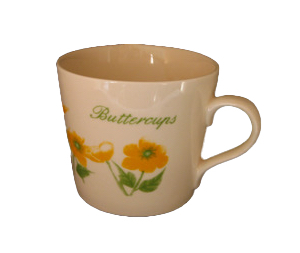
Special model mug Landzeit Buttercups with full decoration (from Henkel zu Henkel) produced for the Rosenberger Austria catering chain, inglaze process.
Burnt vignettes differ in onglaze and inglaze decoration. Precious metals such as gold and platinum, the colours bright red (HKS 185 C, RAL 2000 2002) and sunflower yellow (RAL 1018 1021) cannot be applied using the inglaze process and can be fired at a maximum temperature of 980°C. Every porcelain manufacturer has a standard collection of colours that are suitable for the inglaze process. As a rule, there should be no deviation from this standard collection, as each new colour represents a risk for the manufacturer and end customer in terms of the final finish. For this reason and for their own security, the manufacturers create a so-called firing test to test the compatibility of the new colour composition with the glaze. The basic costs for the creation of this decorative sample correspond to those of a complete production and amount to between EUR 150 and EUR 300 at cost price.
What applies to vignettes also applies to decals. Both the application techniques and the properties of the decals do not differ from those of the vignettes.
In the Porzelliner's use of the term, the decoration refers to a coloured porcelain decoration (porcelain finishing) and the vignette characterises the representation of a customer logo or a desired lettering for advertising or name display. In terms of production technology, however, the processes are identical for both methods.
We explain the 3 major groups in detail:
a) Underglaze
b) Inglaze
c) Hoof glaze
The underglaze decoration
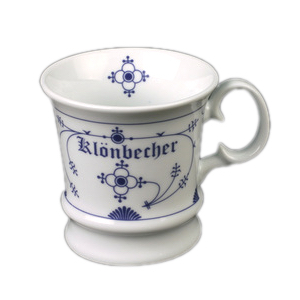
Oat mug "BT 164" with cobalt blue underglaze Indian blue produced for the North German retailer association Küstensouvenir.
As vignettes generally belong to the porcelain decor family, please refer to this section under the heading "Decor types in our product information".
The inglaze process
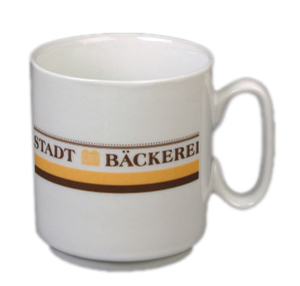
Stacking cup "BC022", decor city bakery with three-coloured inglaze produced for Stadtbäckerei Hamburg.
You can also find a detailed explanation of this in our "Types of decor" section in our product information.
The overglaze process
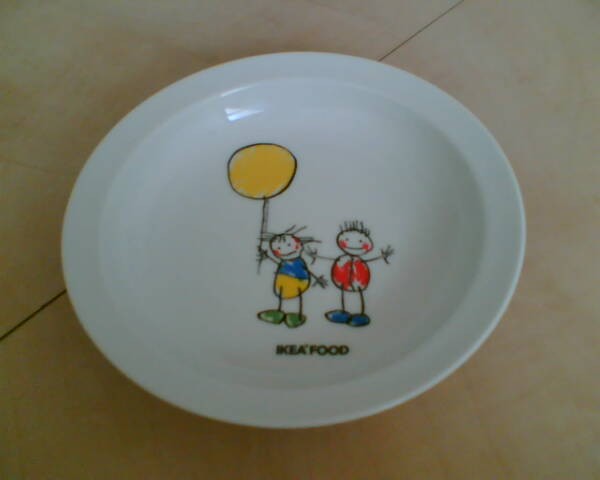
Special plate for children, with five-colour overglaze decoration produced for Ikea Germany & Switzerland
For commercial use, it is important to know that the firing temperature (750-900° C) alone renders the porcelain "dishwasher-safe". On-glaze decorations are not dishwasher-safe but only dishwasher-suitable. However, additional measures can significantly increase the durability of the decor and achieve resistance results on a par with inglaze decor. The Ikea children's plate shown here has been used in Ikea restaurants for several years. The number of wash cycles can easily reach a hundred or more per day. As one of the few suppliers of porcelain, we have succeeded in developing a special decoration protection process in Asia that gives the porcelain unrivalled dishwasher resistance while at the same time maintaining complete conformity, which we have had confirmed by the German TÜV!
More on this under "Types of decor" in our product information.
The sandblasting vignette
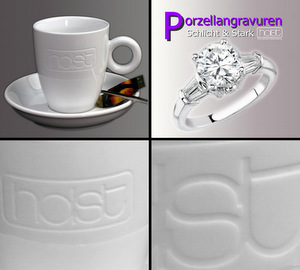
According to the motto "less is more", we believe that sandblasting vignettes are probably the noblest form of individualising porcelain. Often referred to as porcelain engraving, the logo is "scratched" into the glaze of the porcelain using a sandblasting technique. This removes the top layer of the porcelain and the logo (lettering) appears elegant and discreet.
